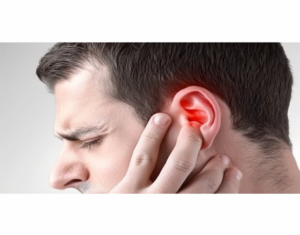Tinnitus, commonly described as the perception of sound without an external source, can manifest as buzzing, ringing, hissing, or roaring sounds. Among its various types, somatosensory tinnitus is particularly notable for its association with musculoskeletal issues, especially those related to temporomandibular dysfunction (TMD).
 What is Somatosensory Tinnitus?
What is Somatosensory Tinnitus?
Somatosensory tinnitus is characterized by tinnitus that is influenced or modulated by the sensory system, particularly through physical movements or manipulations of the head, neck, or jaw. Unlike other forms of tinnitus, which are often related to auditory system dysfunctions, somatosensory tinnitus is closely linked to the musculoskeletal system.
The Link Between Somatosensory Tinnitus and TMD
Recent studies have shown that a significant number of individuals with tinnitus can alter their tinnitus by manipulating the muscles of the neck and face. For instance, up to 69% of people with tinnitus can modulate their symptoms through such actions (Rocha and Sanchez, 2012). This indicates a strong link between somatosensory tinnitus and musculoskeletal issues.
While many patients can modulate their tinnitus, this alone is not a definitive predictor of successful response to musculoskeletal treatment. However, if tinnitus decreases during assessment, it often predicts a positive outcome, with 76% of improvements persisting post-treatment. This improvement is often accompanied by a reduction in the pain of muscle trigger points, which correlates with relief from tinnitus.
Tinnitus and the Temporomandibular Joint (TMJ
The association between tinnitus and TMD is well-documented. Epidemiological studies reveal that patients with both tinnitus and TMD are often younger, more frequently female, and tend to have better hearing function than those with tinnitus alone. TMD is identified as a strong predictor of tinnitus, second only to headache (Ralli et al., 2017). Studies report that the incidence of tinnitus is significantly higher in patients with TMJ disorders, with some findings suggesting an eight-fold increase (Buergers et al., 2015).
Treatment of TMJ disorders has shown promising results in alleviating tinnitus symptoms. For example, Tullberg and Ernberg (2006) reported that 43% of patients maintained a decrease in tinnitus two years after TMJ treatment. Additionally, Wright and Bifano (1997) demonstrated significant improvements in tinnitus with a combined approach of cognitive therapy, bite splints, and home exercises for TMD.
A study in 2014 further supported these findings, showing that a combination of intraocclusal stabilization and physiotherapy, including passive muscle stretching, massaging of the masticatory muscles, thermotherapy, TMJ traction, and coordination exercises, improved tinnitus symptoms in 44% of participants (Manfredini et al., 2014).
Identifying Somatosensory Tinnitus
Ask yourself these questions to determine if your tinnitus may be somatosensory:
- Does your tinnitus worsen when your TMJ or neck pain increases?
- Is your tinnitus unrelated to hearing loss or age-related auditory changes?
- Is your tinnitus linked to stress?
- Can you decrease the tone or pitch of your tinnitus with specific movements or postures?
If you answered “yes” to any of these questions and are experiencing tinnitus without hearing loss, consider exploring treatment options for your neck and TMJ.
Treatment at Sunshine Coast Health Services
At Sunshine Coast Health Services, we are dedicated to addressing the underlying causes of your symptoms. Through comprehensive assessment and a combination of education, advice, manual therapy, and self-care exercises, we aim to resolve your pain and prevent recurrence. We also collaborate with GPs, ENTs, neurologists, orofacial pain specialists, and other healthcare professionals to ensure you receive the best possible care.
Our Services Include:
- Manual Therapy: Techniques to improve jaw and neck function and reduce muscle tension.
- Intra and Extraoral Myofascial Release: Targeted treatments to relieve muscle tightness.
- Dry Needling and Acupuncture: Techniques to alleviate muscle pain and tension.
- Rehabilitation Exercises: Customized exercises to improve TMJ and neck range of motion and stability.
- Posture Re-education: Guidance on maintaining proper posture to reduce strain.
- Psychoeducation and Self-Management Techniques: Education and tools to help you manage your condition independently. This may include Cognitive Behavioral Therapy (CBT) interventions and psychophysiological strategies to regulate your nervous system towards optimal recovery.
If you are suffering from tinnitus and would like to find out if treatment of your neck and TMJ can help reduce your symptoms, please contact us or book an evaluation online.
Disclaimer
The information provided in this blog post is for general informational purposes only and should not be considered as medical advice. It is not intended to be a substitute for professional medical advice, diagnosis, or treatment. Always seek the advice of your physician or other qualified health provider with any questions you may have regarding a medical condition.
The author and publisher of this blog post have made every effort to ensure that the information provided is accurate and up to date. However, medical knowledge and best practices are constantly evolving, and the information in this blog post may not reflect the most current research or medical guidelines. Therefore, the author and publisher make no representations or warranties of any kind, express or implied, about the completeness, accuracy, reliability, suitability, or availability of the information contained in this blog post.
Any reliance you place on the information provided in this blog post is strictly at your own risk. The author and publisher will not be liable for any losses, injuries, or damages from the use of this information.
In addition, this blog post may contain links to other websites or resources. These links are provided for convenience and informational purposes only. The author and publisher are not responsible for the content or accuracy of any external websites or resources linked to in this blog post.
Medical treatments and outcomes can vary significantly based on individual circumstances. It is important to consult with a qualified healthcare professional before making any healthcare decisions or taking any action based on the information in this blog post.
By reading this blog post, you acknowledge and agree to the above disclaimer and understand that the author and publisher cannot be held responsible for any consequences resulting from the use or misuse of the information provided.

